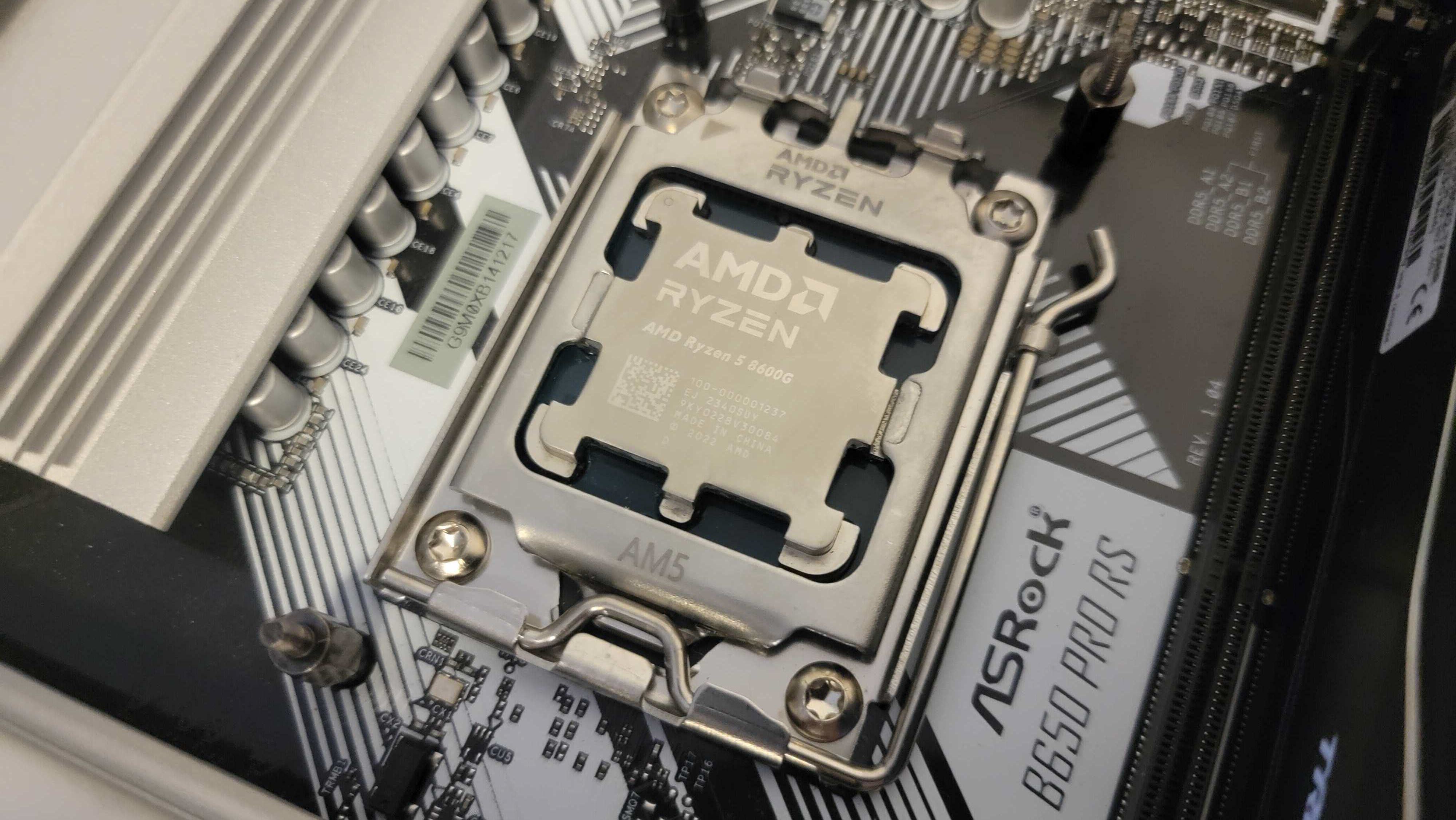Why you can trust Tom's Hardware
AMD's Ryzen 5000G series were a fixture on our Best CPUs for Gaming list for three years due to their convincing and clear value prop for budget gamers on the lowest end of the performance spectrum. Unfortunately, the long-awaited APU refresh, which comes in the form of the Ryzen 7 8700G and Ryzen 5 8600G, moves forward to the AM5 platform, which incurs extra cost for the motherboards and memory. That limits them to an even smaller niche audience and makes it difficult to recommend them over other alternatives. However, if you're determined to build a system around the Ryzen 8000G series of chips, the Ryzen 5 8600G is the model to get.
The charts below outline three areas of performance: The geometric mean of our suite of integrated graphics tests at both 1920x1080 (FHD) and 1280x720 resolutions, the geometric mean of performance with a discrete GPU, and performance in single- and multi-threaded workloads.
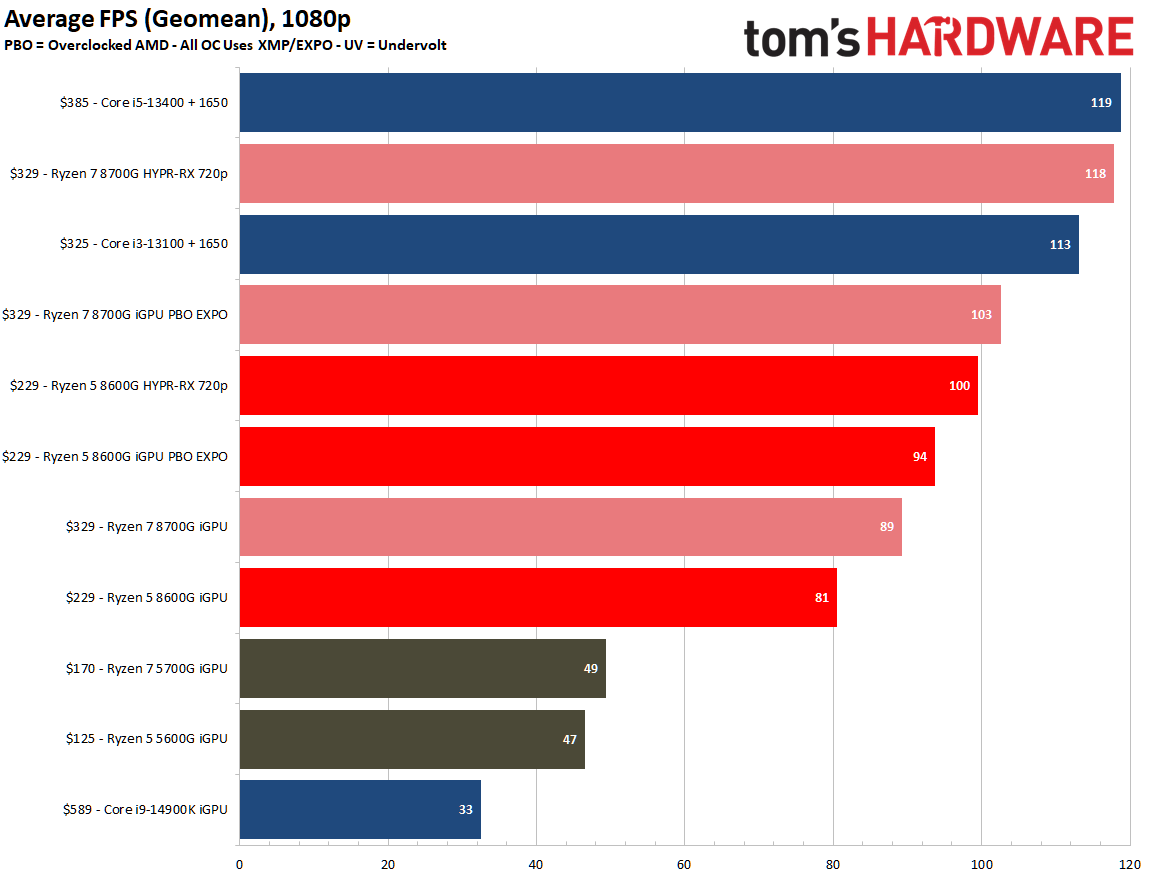
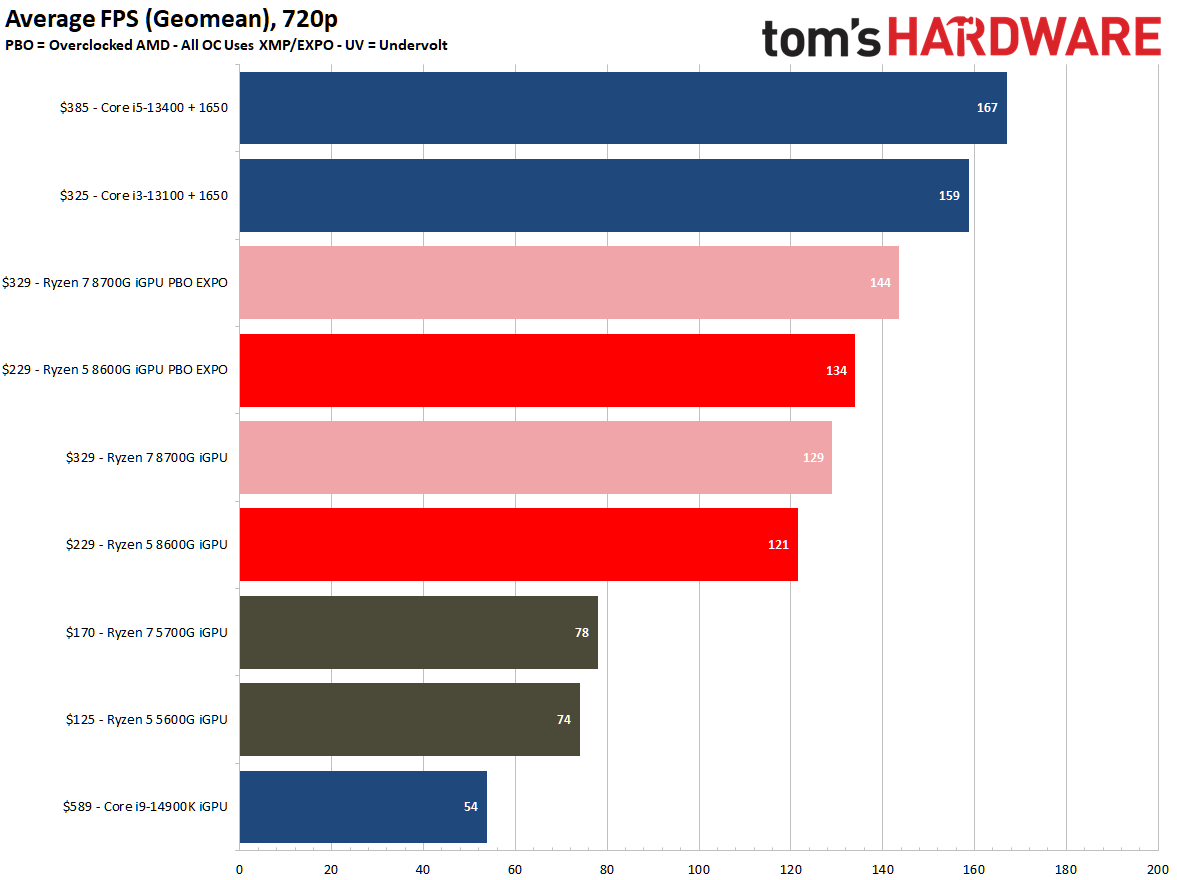
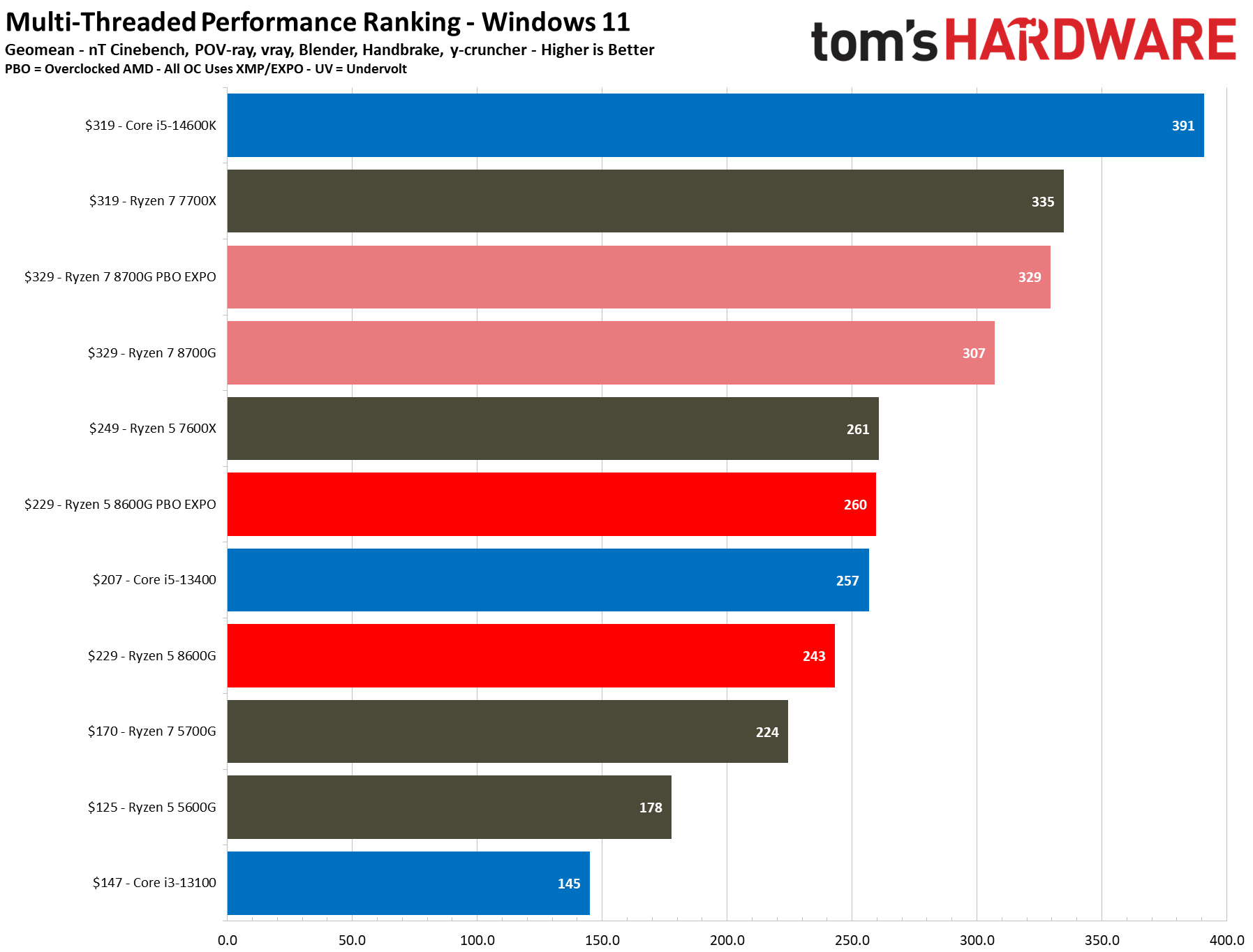
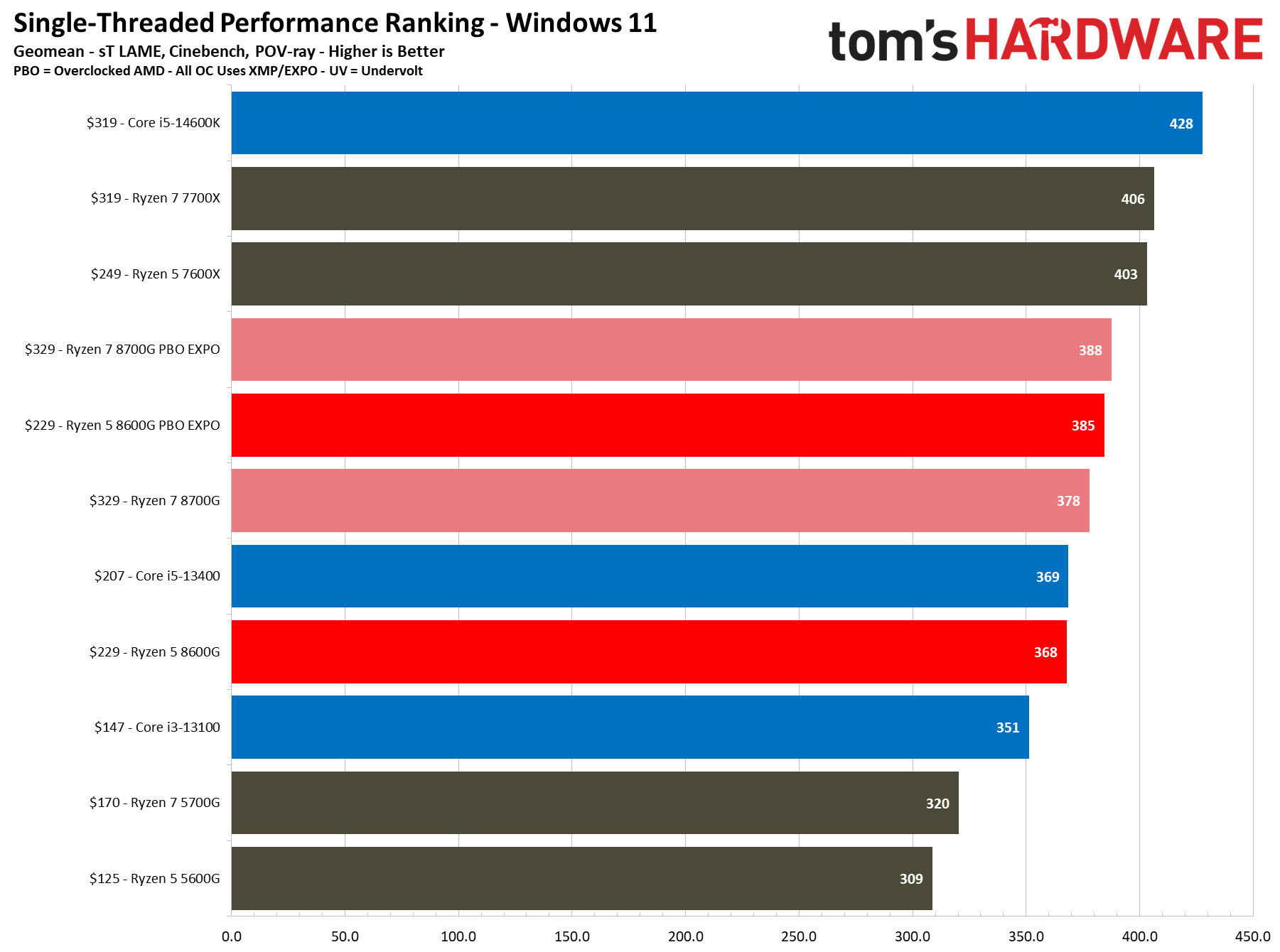
AMD's APUs are geared specifically for budget gaming rigs that don't use a discrete GPU, so the primary focus is on the iGPU benchmarks.
The current-gen flagship APU, the Ryzen 7 8700G, is 10% faster than the 8600G, but it costs $100 (44%) more, making the 8600G the clear value winner for this generation of APUs.
The Ryzen 5 8600G delivers impressive gen-on-gen gains due to the step forward to Zen 4 and RDNA 3 — overall, the chip is a massive 72% faster than its predecessor, the Ryzen 5 5600G, in 1080p gaming. Moving to 720p, the 8600G is 112% faster.
There's a fly in the ointment, though. The competing Core i3-13100 and GTX 1650 combo is much faster, and you could pair a previous-gen version of that chip, or an AMD chip, with an even lower-end GPU (like the RX 6600) and still come out ahead on performance while shrinking the pricing gap. The CPU+GPU combos also don't require quality-sapping upscaling to be competitive.
You also have to consider the higher costs associated with the AM5 platform. AMD has said that it will continue to bring new value processors to the AM4 platform due to the continued high pricing for DDR5, hinting that AM5's high pricing will persist for some time. You'll also need DDR5 memory, and while DDR5 pricing has fallen from the stratospheric heights we saw at launch, it remains significantly more expensive than DDR4.
The power use of an Intel CPU with an Nvidia GPU is substantially higher than the AMD APUs alone. AMD has a 65W TDP that accommodates a peak of 88W. The Nvidia GTX 1650 GDDR6 can use 75W alone, sometimes a bit more depending on the model, and the CPU adds another 65W. That means the AMD system will consume far less power, which is ideal for SFF and passively cooled systems.
The Ryzen 5 8600G does have impressive overclocking potential, especially in titles that benefit from increased memory bandwidth. Like the 8700G, the 8600G benefits from increased bandwidth more than low timings, so you don't have to splurge on the priciest EXPO kits. However, DDR5 pricing again rears its head when you're looking for the fastest overclockable memory kits.
AMD does have the distinction of being the first to offer a dedicated AI accelerator for the desktop PC, but that's a bit of a shallow win for now. AMD finds itself in a chicken-and-egg scenario here, as precious few applications currently leverage the unit. That will change in the future, but the AI engine will go largely unused for now.
AMD's desktop APUs may serve a small market, but the company rules the niche without any competition. Adding Hyper-RX with RSR and AFMF is a boon for budget gamers who are more willing to compromise on quality, but the performance of the competing CPU+GPU combos takes away some of that shine.
Yes, APUs serve an increasingly niche audience seeking high-performance systems without a discrete graphics card, such as some SFF and passively cooled system builds. We think AMD's pricing misses the mark on this generation of APUs, but if you were to select an 8000G model for your next build, the Ryzen 5 8600G is a far better value than the Ryzen 7 8700G, making it the go-to APU for this generation.
- MORE: AMD vs Intel
- MORE: Zen 4 Ryzen 7000 All We Know
- MORE: Raptor Lake All We Know
Get Tom's Hardware's best news and in-depth reviews, straight to your inbox.
Current page: Not the best value, but still a better value than the flagship
Prev Page AMD Ryzen 5 8600G Application Benchmarks
Paul Alcorn is the Editor-in-Chief for Tom's Hardware US. He also writes news and reviews on CPUs, storage, and enterprise hardware.
-
Notton Considering how the Core 5 135H is looking, I really wish AMD enabled the full 12CU from this chip.Reply -
usertests APUs are screaming for more memory bandwidth, and the 8600G will look great if it hits the low prices seen for the 5600G along with other platform costs getting cheaper.Reply -
baboma >The current-gen flagship APU, the Ryzen 7 8700G, is 10% faster than the 8600G, but it costs $100 (44%) more, making the 8600G the clear value winner for this generation of APUs.Reply
This is incorrect, because you do not use the APU by itself, but as a part of a system. The correct value calculation is to take the price delta of the entire system but with different APUs.
Assuming a $1K SFF build, the $100 APU price diff would come out to ~10%, which is the same perf diff between 8700G and 8600G. AMD did its pricing homework. The value proposition is the same for both APUs.
I agree both are niche, as their main appeal would be for small SFF (eg NUC), and in that space, mobile parts, eg MTL & AMD 780M parts, may have more functionality and be better value.
>...the 8600G will look great if it hits the low prices seen for the 5600G along with other platform costs getting cheaper.
That'll happen if you're willing to wait ~2 years until the 9600G's release.
5600G pricing was very stable, staying close to its $259 launch price, and only gradually dropping after the 7000 series release on Sep'22.
https://camelcamelcamel.com/product/B092L9GF5N -
jeremyj_83 "Higher DDR5 pricing, no 8GB options"Reply
I am so tired of hearing about DDR5 pricing being a con. While it is more expensive, you won't have a choice for a new CPU in the Zen 5 or 15th Gen anyways. Not to mention due to the added bandwidth the 8600G averages 72% more iGPU performance at 1080p vs the 5600G. If you are looking at doing only iGPU gaming that added cost is minimal compared to extra performance. The lack of an 8GB option is also not a con. Gaming on 8GB is with a dGPU isn't good, unless it is old games. Doing it on an iGPU can kill your performance completely. -
SunMaster I think in most cases the APU will be preferable over the CPU with the old graphics card.Reply
If price is your only reason to go for a system like this, and you badly want to game, the APU isn't the best solution. But case/enclosure size, heat and noise will be the primary reason to choose the APU. The fact that you actually can game on it will what makes the sale. -
Reply
A few years ago I played through the entirety of Star Wars Jedi: Fallen Order on a Ryzen 3200G (no dedicated GPU) and with a 4GB x 2 kit of RAM. The Series S also works fine with what is functionally only 8 GB of RAM shared between the CPU and GPU (there's technically +2 GB for a total of 10, but the extra 2 GB is clocked slow and is for the OS). Memory needs tend to be overstated.jeremyj_83 said:The lack of an 8GB option is also not a con. Gaming on 8GB is with a dGPU isn't good, unless it is old games. Doing it on an iGPU can kill your performance completely. -
jeremyj_83 Reply
Have you tried to do basic work on a computer with Win 10, 8GB RAM, and 2GB RAM reserved for the iGPU? It is painfully slow as you are page swapping all the time. Any computer that isn't a Chromebook should come with less than 16GB RAM now.HopefulToad said:Memory needs tend to be overstated. -
kyzarvs Reply
My desktop is a 32GB ram machine. I also have an i7 / 32gb / 2TB nvme gaming laptop.jeremyj_83 said:Have you tried to do basic work on a computer with Win 10, 8GB RAM, and 2GB RAM reserved for the iGPU? It is painfully slow as you are page swapping all the time. Any computer that isn't a Chromebook should come with less than 16GB RAM now.
When I want portability on the road, I have a dell notebook that's education-oriented. 4GB ram, no fans, small CPU. It runs 10/11 perfectly well, starts up quickly and performs my work requirements (Office / Firefox / NextCloud) pretty much as quick as my main machines. -
mitch074 Erm... Error in the article : Zen3 was using 7nm, not 12 - AMD dropped 12nm with Zen 2 and RDNA.Reply
